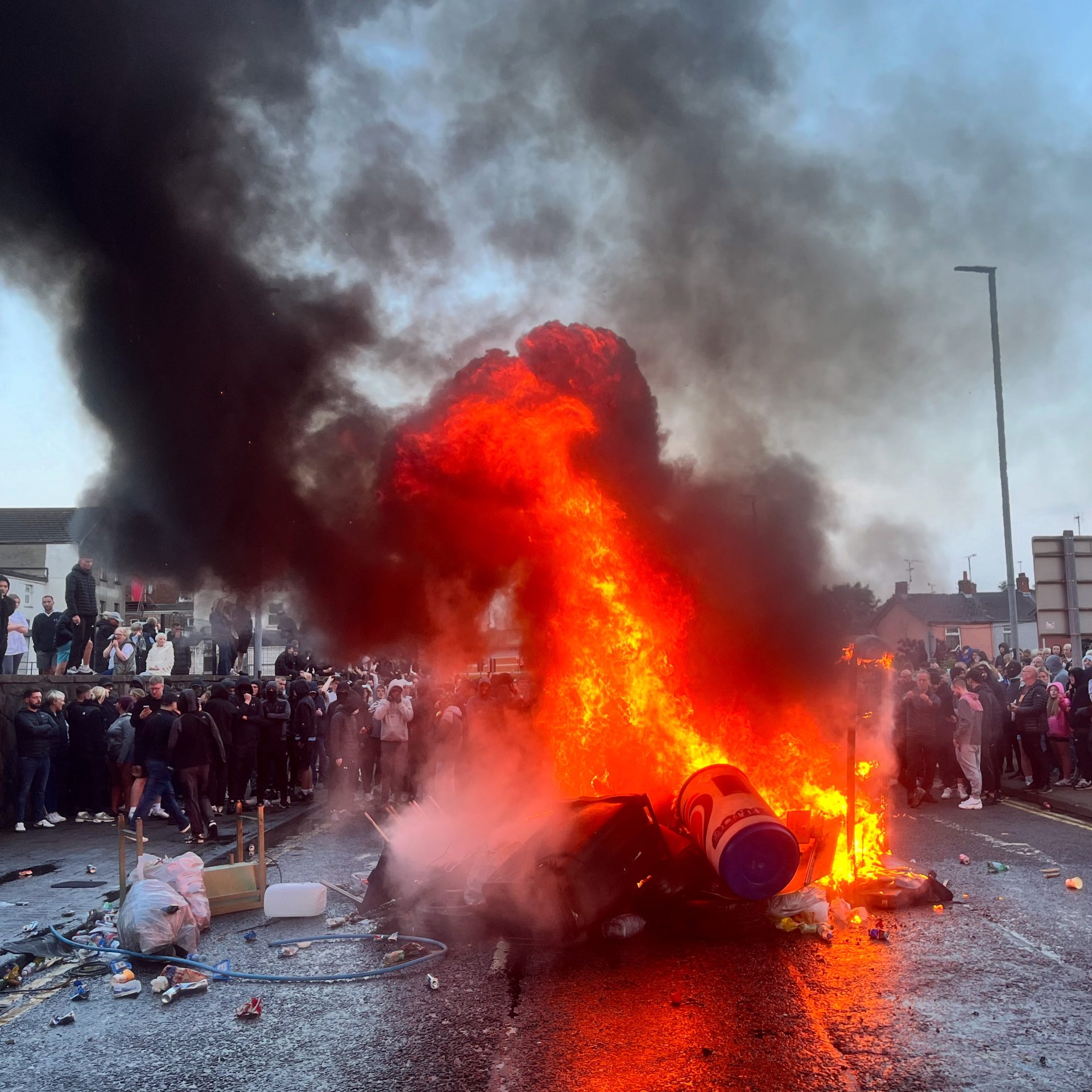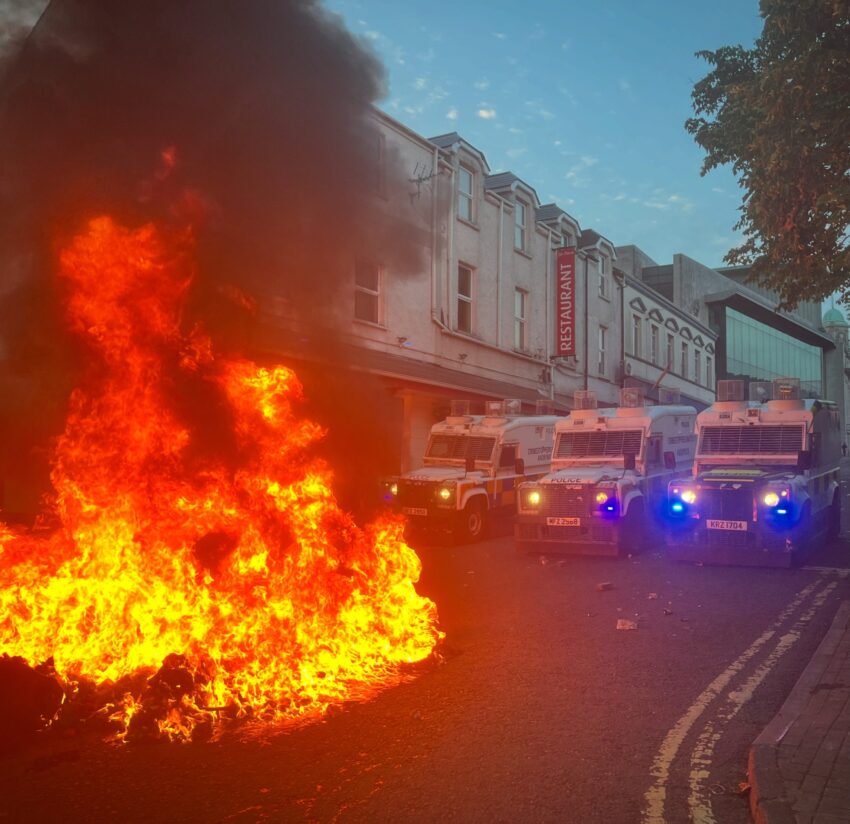“We’ll have a wee bonfire tonight,” a Ballymena woman laughed as masked youths built barricades of burning wheelie bins and advertising hoardings, while others smashed in and set light to an unattended car. It was the second night of rioting in the rural town in County Antrim’s Protestant, Ulster-Scots heartland, following the arrest of two Romanian Roma teenagers and one man for the alleged sexual assault of a local girl, the second such incident blamed on migrants in just a few weeks.
During Monday night’s disturbances, rioters focused their attention on housing occupied by the alleged perpetrators and other Roma in Ballymena’s Clonavon Terrace, smashing in windows and setting fire to the hurriedly vacated houses. In the nearby village of Culleybackey, the car and home of a Filipino migrant, entirely unconnected to the alleged assault, was also firebombed. In Ballymena, Filipino residents affixed Filipino and Union flags to their doors to ward off attacks by locals.
But on Tuesday night, with a much larger crowd, the local anger was directly squared against the police. Young rioters in black sportswear and ski masks built barricades and hurled missiles at PSNI armoured Land Rovers, while crowds of onlookers cheered them on. Middle-aged women clapped and jeered triumphantly when one policeman was struck directly on the head by a hurled rock. “Right in the head, nice one,” another middle-aged woman said, observing a well-aimed firework strike a police officer. Police fired baton rounds at protestors to disperse the crowd, extinguishing burning barricades with cold jets from their water cannon as rocks and bottles smashed against their vehicles.
Rioting is hardly a new development in Northern Ireland, especially on warm summer nights. What is novel, however, is the focus on mass migration as the proclaimed rationale, a process accelerated by the recent uptick in asylum seekers dispersed to Northern Ireland by the Westminster government to take advantage of the province’s low-cost housing. In a country whose unhappy history is defined by the 17th-century Plantation of Scottish settlers — the ancestors of Tuesday night’s rioters — this latest wave of settlement has introduced a volatile new element to the country’s politics. “Within the last two or three years, I think Northern Ireland just got to the stage now where it’s like, we’ve had enough,” Julian, a local man, told me, as he watched youths hurling rocks at the police. “This is probably the first time now it’s really kicking off, but it’s starting to creep up slowly, I think, around the rest of the country, in [the Republic of] Ireland as well.”
In a mostly Protestant town bedecked with Union flags and Loyalist paramilitary imagery, one striking note was how often protestors referred to parallel but distinct anti-migrant riots in the Republic of Ireland when asked to explain why they were on the streets. “Down south, Dublin’s really kicking off,” Julian told me. “They’re [migrants] coming through from England, and then they’re going into the Republic, and they’re making their way from the Republic up to here. And the Republic of Ireland and Northern Ireland are now coming together, so even though there’s a border between the two countries, both of them know what’s going on.” Yet while Ulster Protestant anti-immigration protestors increasingly allude to a common cause with their Catholic neighbours — a dynamic vastly exaggerated by external commentators — the feeling is not reciprocated. What little overt anti-immigration sentiment is expressed by Northern Irish Catholics manifests instead in travelling down to mass protests in the Republic.

I asked one 17-year-old youth, who chose not to give his name, whether the rioting would spread. “I hope so, aye,” he replied, telling me that they were protesting against “corruption in the government, opening the borders and so on”. Which government, I asked, the devolved parliament in Stormont — increasingly the focus of Ulster Loyalist dissent — or the British government in Westminster? “We don’t have a government here, we never had. So we are more protesting about Westminster and opening all the borders. Keir Starmer, you know.” Rumours spread among the crowd that police from England, Wales and Scotland were being brought in to suppress the disorder. Eager to remain part of the British state around which their community identity revolves, these rioters were also willing enough to confront any forces of order introduced from the “mainland”.
Convoys of armoured PSNI Land Rovers raced through the burning barricades, jeered and taunted by local rioters beneath a wallside mural of William of Orange. Using charges of riot police and a water cannon, the PSNI slowly moved the rioters away from migrant housing towards the centre of town, where they set up new barricades, tearing down tourist information billboards to feed the flames. One pensioner in a motorised wheelchair, wearing a Roman legionary’s helmet, weaved in and out of the water cannon jet to loud cheers. As a line of riot police fell back against their Land Rovers under a barrage of rocks and bottles, Rob, a Liverpudlian who claimed to be a military veteran, shouted at them to “put your fucking guns down, you faggots”.
“I think it’s pathetic that they’re raising guns against their own people, it’s pathetic,” Rob told me angrily. “They’re the police, they’re supposed to be protecting the people. What the fuck have they got guns for? There’s little girls that are getting raped by fucking grooming gangs and look who shows up to get the people who are outraged.” Like Rob, locals furiously accused the PSNI of “protecting” the alleged perpetrators, by which they meant preventing the angry mob from dealing out its own rough justice.

Unusually for such occasions, teenage girls in black balaclavas were prominent at the forefront of the fight, angrily hectoring the police and daring them to advance while youths behind them lobbed rocks and bottles over their heads. “They’re protecting people who are doing this to young girls,” one teenager, who claimed to know the alleged victim, told me. “We’re getting justice for her cousin,” she said, indicating her ski-masked friend, “and justice for every girl who doesn’t feel safe in her town any more.” Eventually, after rioters smashed in the windows of a house occupied by migrants and set fire to the curtains, heavily equipped police in Land Rovers broke up the riot, dispersing the crowd away from the town centre at baton point and clearing a path for fire engines. In the deserted fire station, a miserable-looking Filipino couple stood next to their suitcases waiting for a ride away from Ballymena, unwilling to talk.
This week’s riots are likely to soon fizzle out, as summer riots usually do. But like last year’s protests in Sandy Row, sparked by the disorder in Northern England, the violence in Ballymena displayed new trends in disaffection within the country’s working-class Loyalist communities. Becoming a demographic minority in Northern Ireland, some Ulster Loyalists seem increasingly disenchanted with both their own devolved government and the British state whose symbols they so proudly defend, now seen as the engine of their displacement. “The anger’s against the politicians bringing in all these illegal immigrants,” Gus, an older man, told me. “The problem’s in Stormont and Westminster and everywhere. If this is the only way to get them [migrants] out of the town, then this is the way.”
Click this link for the original source of this article.
Author: Aris Roussinos
This content is courtesy of, and owned and copyrighted by, https://unherd.com and its author. This content is made available by use of the public RSS feed offered by the host site and is used for educational purposes only. If you are the author or represent the host site and would like this content removed now and in the future, please contact USSANews.com using the email address in the Contact page found in the website menu.









